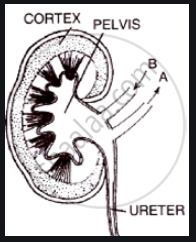Advertisements
Advertisements
प्रश्न
The given diagram represents a nephron and its blood supply. Study the diagram and answer the following questions:

(i) Label parts 1, 2, 3 and 4.
(ii) State the reason for the high hydrostatic pressure in the glomerulus.
(iii) Name the blood vessel which contains the least amount of urea in this diagram.
(iv) Name the two main stages of urine formation.
(v) Name the part of the nephron which lies in the renal medulla.
उत्तर
(i)
1 – Collecting duct
2 – Distal convoluted tubule (DCT)
3 – Descending limb of loop of Henle
4 – Bowman’s capsule
(ii) The diameter of efferent arteriole is narrower than the diameter of the afferent arteriole which builds the high hydrostatic pressure in the glomerulus.
(iii) Efferent arteriole
(iv) The two main stages of urine formation are ultrafiltration and tubular reabsorption.
(v) Henle’s loop and collecting tubules
संबंधित प्रश्न
The diagram given below shows the male urinogenital system of a human being. Study the diagram and answer the questions that follow:

(i) Label the parts numbered 1 to 8.
(ii) Name the corresponding structure of part (4) in female reproductive system.
(iii) What is the role of part 7?
What gaseous waste products are excreted by plants?
Differentiate between the following pairs of term :
Renal pelvis and renal papilla
Choose the odd one out in the following series:
Renal fat, renal capsule, nerve.
Given below is a highly simplified diagram of the human kidney cut open longitudinally. Answer the question that follow:
Write two differences in composition of the blood flowing through the blood vessels, 'A' and 'B'.

Name the Following
The term used for Bowman’s capsule and glomerulus together.
Choose the correct option.
Which one of the following organisms would spend maximum energy in the production of nitrogenous waste?
Choose the correct option.
Specific gravity of urine would _______ if level of ADH increases.
Explain the importance of soil for plant growth.
